Nearshore staffing has become one of the most effective ways for U.S. SaaS companies to scale.
Instead of fighting tight local markets, teams look to Latin America for engineers, specialists, and business talent who can work in sync with U.S. hours.
The appeal comes down to a few clear advantages:
- Cost efficiency compared to the U.S. hiring markets
- Access to highly skilled professionals across engineering, GTM, and operations
- Real-time collaboration with teams in overlapping time zones
- Cultural compatibility that makes communication smoother than offshore models
This guide explains nearshore staffing, the hiring models that exist, the roles that are most frequently filled, and the top countries U.S. B2B SaaS companies look to when building distributed teams.
What is Nearshore Staffing?
Nearshore staffing is a hiring model in which U.S. companies work with teams located in neighboring countries, most often Latin American countries, to fill critical roles without the delays or high costs linked to offshore outsourcing.
The model combines access to a broader global talent pool with time zone compatibility, which allows for smoother real-time collaboration, and is widely used in software development, business process outsourcing, and project-based work where companies need specialized skills.
Nearshore partners handle sourcing, screening, and placement, while internal teams focus on integration and delivery.
Key benefits of nearshore staff include:
- Time zone compatibility for standups, sprint reviews, and daily syncs
- Cultural alignment and cultural affinity that reduce language barriers
- Cost savings from lower hiring costs and regional labor costs
- Access to specialized talent in engineering, data, and IT operations
- Flexible staffing solutions for staff shortages or a particular project
Companies turn to nearshore staff augmentation when internal teams cannot cover critical roles or when scaling requires quick access to qualified candidates.
What is Staff Augmentation?
Staff augmentation is a hiring model where companies bring in external talent to work with in-house employees for a set time. The setup allows teams to access skilled professionals without committing to full-time contracts.
SaaS companies rely on it when deadlines are tight, staff shortages appear, or complex projects demand specialized talent not available internally.
Key factors in staff augmentation:
- Access to specialized talent without lengthy recruiting cycles
- Cost savings and lower hiring costs compared to local markets
- Dedicated team options that align with the existing team
- Cultural compatibility for better communication and real-time collaboration
- Scalability to cover critical roles or add support for a particular project
For many tech leaders, staff augmentation is cost-effective within more general strategic staffing solutions. It lets companies efficiently accomplish growth targets while keeping quality control intact.
Nearshore Staffing vs. Staff Augmentation: What’s the Difference?
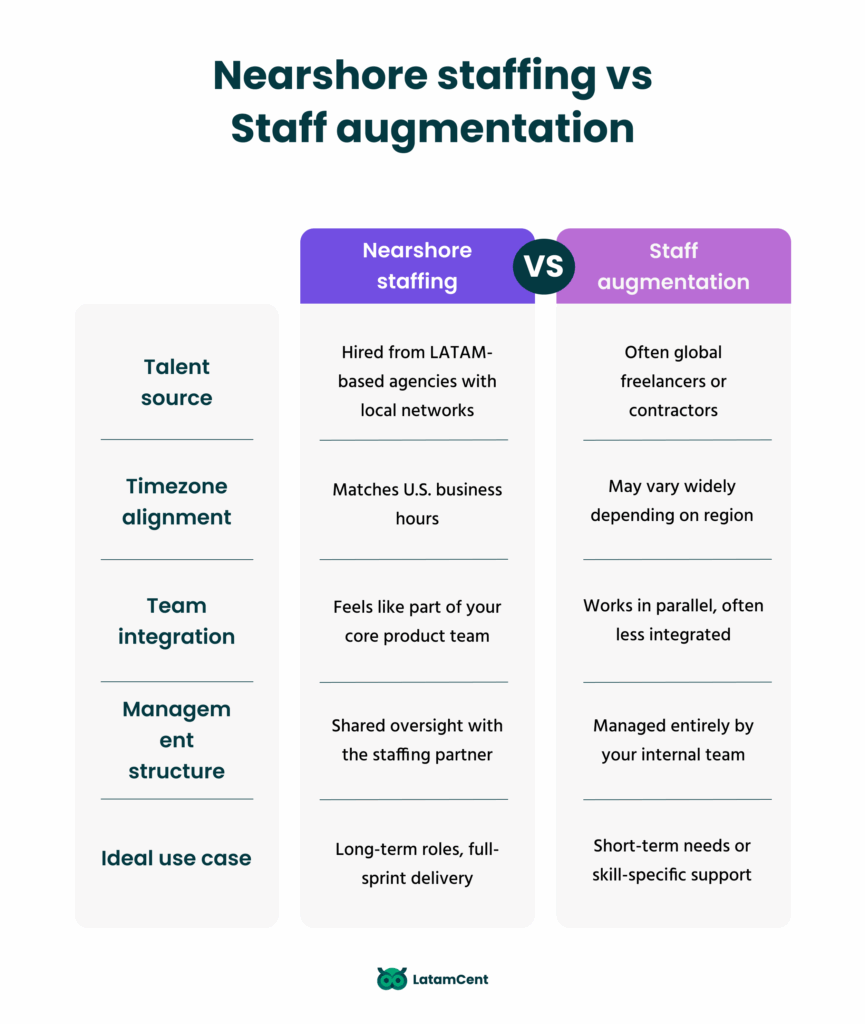
Nearshore staffing places nearshore teams in a nearby country so U.S. companies gain the same time zone collaboration, cost efficiency, and easier communication.
Nearshore partners run nearshore staffing services, sourcing highly skilled professionals, handling cross‑border admin, and building a dedicated team that stays embedded with in-house teams for ongoing work.
Staff augmentation adds external teams or individual specialists to an existing team to cover specific skills or extra capacity. Geography is flexible: local talent, nearshore staff augmentation, or even offshore teams. The client directs daily work; vendors provide access to top talent faster than typical market hiring.
Key differences between nearshore staffing and staff augmentation:
- Scope: Nearshore staffing = location‑driven model within neighboring countries; staff augmentation = capacity/skills model anywhere.
- Ownership: Nearshore, the vendor assembles a steady tech talent pod; augmentation, the client plugs in skilled professionals under its managers.
- Rhythm: Nearshore = longer horizon and continuity; augmentation = elastic headcount for spikes, experiments, or critical roles.
- Levers: Nearshore focuses on time zone fit, cultural compatibility, and lower cost; augmentation emphasizes speed, niche specialized talent, and easy scale.
- Use cases: Nearshore refers to product squads and ongoing roadmaps, while augmentation refers to business needs like migrations, audits, or complex projects.
Choose nearshore staffing when real-time collaboration, cost effectiveness, and steady teams matter most.
Choose staff augmentation when speed, niche expertise, and flexible capacity make all the difference.
Benefits of Nearshore Staff Augmentation for US Companies
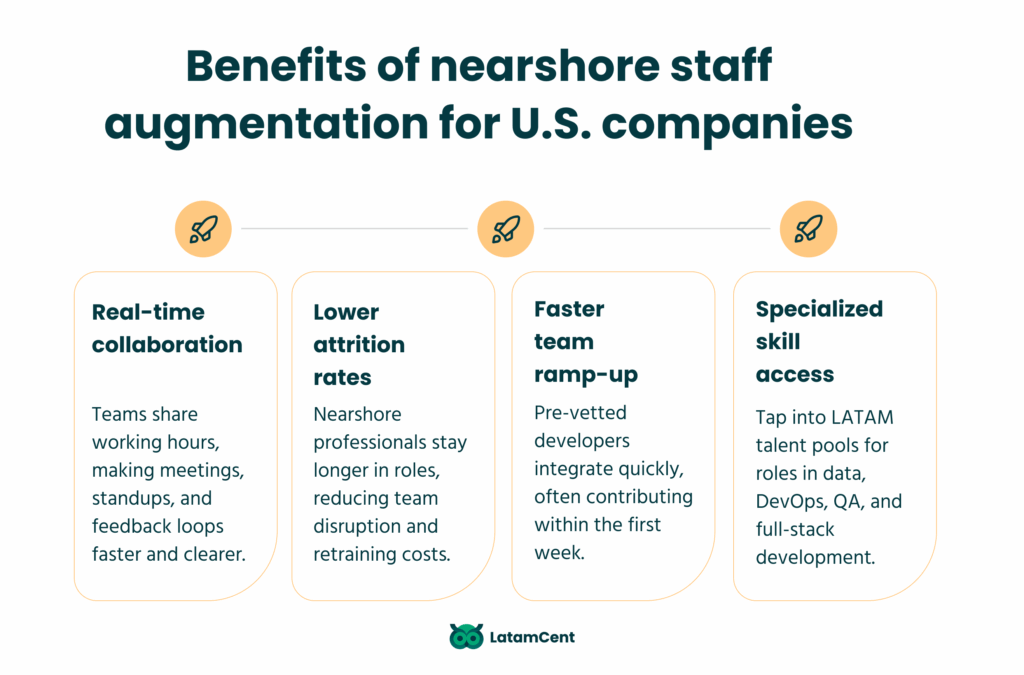
Time Zone Alignment & Real-Time Communication
Time zones don’t sound like a big deal until you’ve lost a full day waiting for answers. Offshore teams extend conversations between continents, and a single bug fix can take 24 hours to resolve.
In SaaS, that kind of delay carries product velocity to a crawl.
Nearshore staff augmentation removes that lag. Developers in neighboring countries share the same working hours as U.S. teams, so standups, sprint planning, and product reviews happen in real time.
Questions get answered on the spot, and blockers vanish before they derail an entire sprint.
Nearshore staffing services also provide access to quality talent who are comfortable with agile workflows. Instead of forcing in-house teams to adjust their schedules, nearshore teams adapt seamlessly, creating collaboration that feels natural rather than forced.
For companies under pressure to move quickly, time zone alignment is convenient and one of the most cost-effective ways to keep projects on track.
Lower Churn Compared to Offshore Options
Turnover is one of the biggest hidden costs in tech hiring.
Every time an engineer leaves, the team loses context, projects slow down, and managers spend weeks filling the gap. Offshore models make this worse; distance, cultural differences, and misaligned expectations all push churn higher.
Nearshore staffing services tend to keep talent longer. Engineers in neighboring countries see clearer career opportunities, share more with U.S. company culture, and often prefer the stability of nearshore placements over short freelance contracts. That translates into fewer replacements, less disruption, and stronger knowledge retention inside SaaS teams.
For companies scaling quickly, stability is worth as much as speed. With nearshore staff augmentation, you get both.
Faster Onboarding & Stronger Collaboration
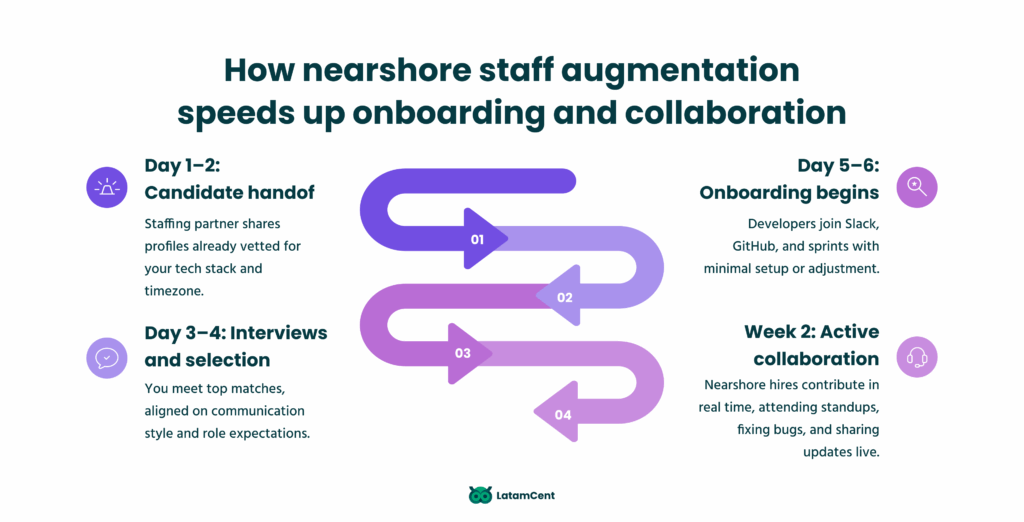
Hiring delays can stall entire roadmaps.
Every week spent sourcing candidates or negotiating contracts is a week lost on product delivery. Offshore models often make this worse, with slow vetting cycles and long adjustment periods once a hire finally joins.
Nearshore staff augmentation speeds up that process. Recruiters in neighboring countries already maintain pipelines of vetted engineers, QA specialists, and product roles.
That preparation trims weeks off the hiring timeline.
The benefit doesn’t end at faster start dates. Once onboard, nearshore teams share the same time zone and cultural context, so collaboration with U.S. managers and in-house engineers feels natural. Instead of struggling through mismatched schedules, teams move directly into building features, fixing bugs, and shipping product updates together.
For SaaS companies under pressure to release quickly, faster onboarding and immediate collaboration can be the difference between hitting milestones and missing the market window.
Access to Specialized Remote Talent
Certain roles are difficult to fill in the U.S. market.
Data engineers, DevOps specialists, and AI/ML experts are in high demand, and competition pushes salaries and timelines beyond reach. Relying only on local hiring often leaves critical seats unfilled for months.
Nearshore outsourcing opens that talent pool. Latin America has a deep supply of highly skilled professionals trained in modern frameworks, cloud platforms, and emerging technologies. Nearshore staffing services connect U.S. companies with this specialized talent, ensuring projects aren’t delayed because of local shortages.
The model also makes it easy to scale for complex projects.
Businesses can partner with nearshore teams to add external specialists while keeping in-house employees focused on core priorities. That flexibility gives SaaS companies the depth of expertise and the speed needed to compete.
Nearshore Hiring Models Explained
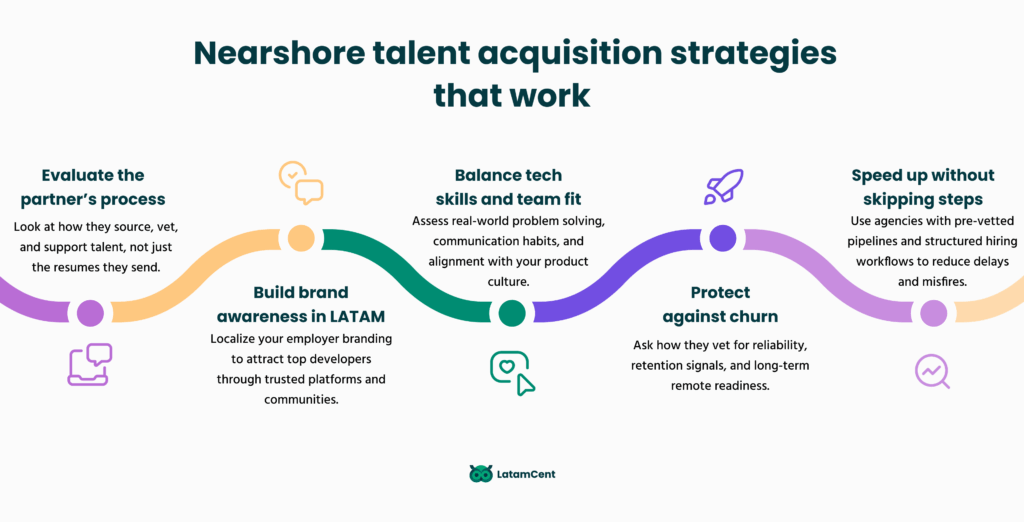
Direct Hire via Employer of Record (EOR)
Expanding into Latin America usually means dealing with payroll, contracts, and compliance in a new jurisdiction. For most U.S. startups, setting up a legal entity just to hire a few engineers isn’t realistic.
That’s where the Employer of Record model comes in.
An EOR is the legal employer on paper, handling everything from tax filings to benefits administration, while the U.S. company directs the day-to-day work.
The advantage is speed. Companies can secure top talent in a nearby country without months of legal setup. It’s a straightforward way to bring in highly skilled professionals while complying with local labor laws.
Dedicated Remote Teams Under Your Management
Some companies prefer a more hands-on model. Instead of hiring one or two individuals, they assemble a full dedicated team sourced through a nearshore partner but managed directly by their own leads.
In practice, that might look like a five-person product squad, engineers, a QA lead, and a designer, all based in Latin America, working U.S. hours, and reporting into the client’s product manager.
The benefit is control.
You’re not just tapping external talent for a project; you’re building an extension of your in-house team. Daily communication happens in real time, processes mirror what you already run, and collaboration feels smooth.
For SaaS companies scaling aggressively, dedicated teams under direct management give the flexibility of nearshore outsourcing with the familiarity of an in-house setup.
Hybrid: Staffed but Co-managed Teams
Not every company wants to own team management fully, but also doesn’t want to hand everything over to a vendor. A hybrid model combines that middle ground.
In this setup, the nearshore partner handles recruiting, HR support, and day-to-day logistics, while the client manages technical direction and priorities. Think of it as shared responsibility: the provider keeps the team stable, and the company keeps the roadmap aligned.
For SaaS companies juggling growth with limited internal resources, co-managed teams offer balance, enough management to maintain quality, without the overhead of managing every detail.
Project-Based Nearshoring vs. Role-Based Nearshoring
The distinction here comes down to scope.
Project-based nearshoring involves bringing in a full external team to deliver a defined outcome, such as a new product feature or a data migration. Once the project ends, the engagement often wraps up as well.
Role-based nearshoring, on the other hand, focuses on filling individual positions.
Companies add one or two engineers, a QA specialist, or a product designer who join existing squads and work as if they were in-house employees.
Both models have value. Project-based nearshoring works well for companies with a clear deliverable and a fixed timeline. Role-based nearshoring suits teams that need long-term capacity, continuity, and alignment with existing workflows.
Nearshore Talent Acquisition Strategies That Work
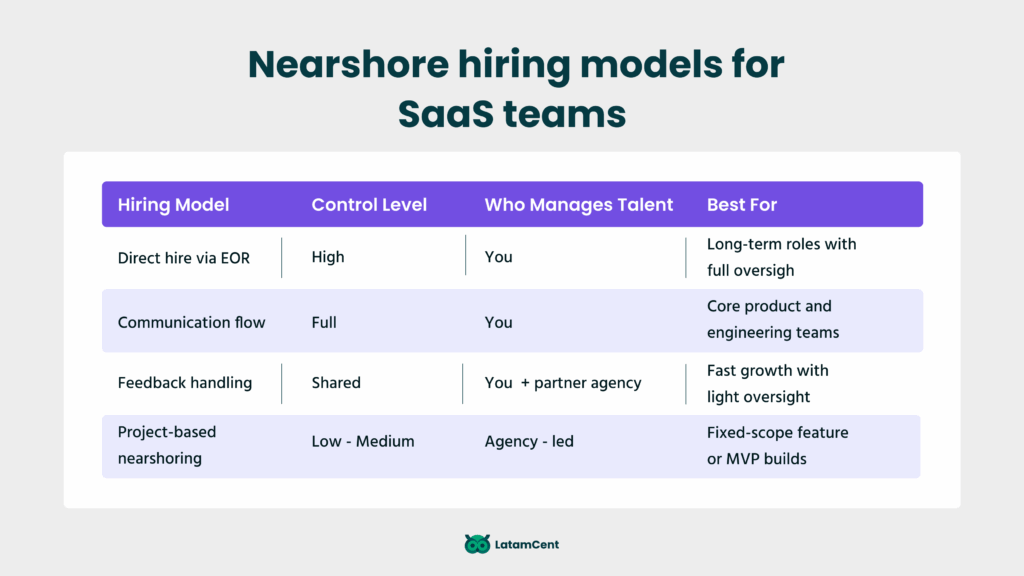
Leading companies don’t just compare costs when choosing nearshore partners.
They ask for proof, such as sourcing methods, screening steps, and retention results. Transparency is what separates reliable vendors from résumé pushers.
In LATAM, employer branding matters. Developers and product specialists want career growth and stability. U.S. companies that highlight culture, advancement, and strong leadership attract stronger applicants.
Hiring managers also balance more than technical tests. They look at communication, teamwork, and long-term retention risk. A well-coded feature isn’t much help if collaboration breaks down.
To reduce delays without cutting corners, many rely on pre-vetted candidate pools. That way, they gain speed while still protecting quality.
What works best in practice:
- Vet nearshore partners for sourcing and retention data
- Invest in employer branding across LATAM markets
- Balance technical fit with soft skills and staying power
- Use pre-vetted pools to shorten hiring cycles without losing quality
What Roles Are Most Commonly Hired Through Nearshore Staffing Companies?
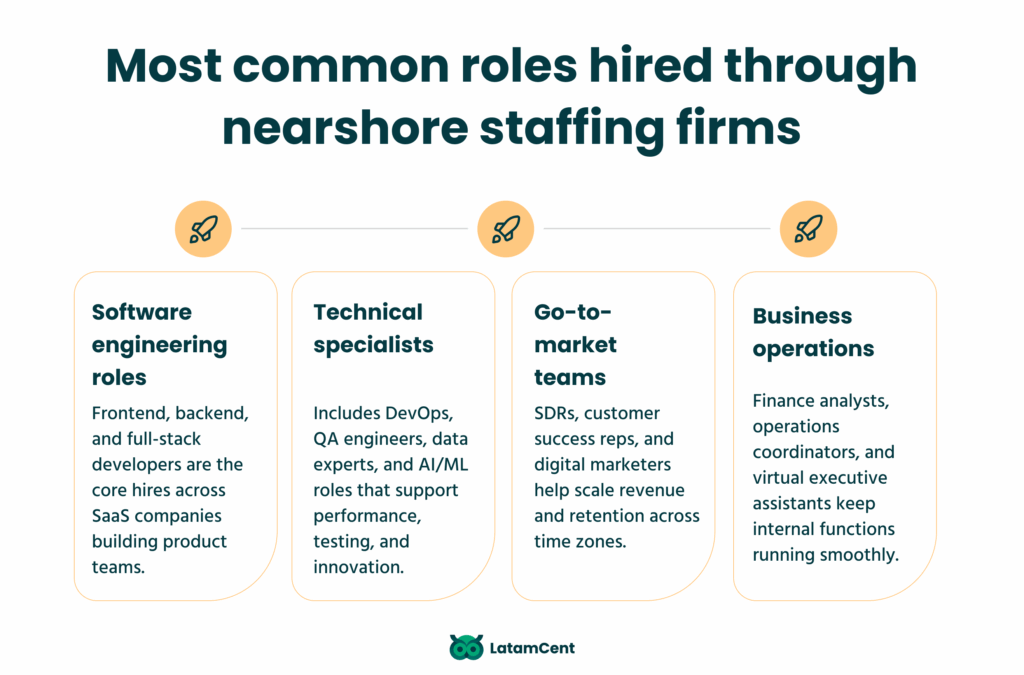
Software Engineers: Frontend, Backend, & Full Stack
Most nearshore staffing companies place software engineers first. Demand for front-end developers who build intuitive interfaces in React or Angular is constant. Back-end engineers skilled in Node.js, Python, or Java keep products stable and scalable.
Startups also heavily rely on full-stack developers, professionals who can handle both sides of the stack and shift tasks as priorities change. That flexibility makes them a popular choice for early-stage SaaS teams.
Key areas of focus include:
- Front-end frameworks for responsive UIs
- Backend logic, APIs, and integrations
- Full-stack roles for companies needing one hire to cover both ends
Technical Specialists: DevOps, QA, Data, & AI Engineers
Software doesn’t run smoothly without specialists behind the scenes.
DevOps engineers automate deployments and keep infrastructure efficient. QA engineers catch bugs before customers do. Data engineers build pipelines that make analytics reliable. AI/ML specialists design models that power automation and smarter features.
Nearshore staffing services source these specialists because they’re hard to find quickly in the U.S. market. LATAM provides a deep pool of professionals with these niche skills, available faster and often at a more cost-effective rate.
Companies rely on specialists for:
- DevOps automation and cloud infrastructure
- QA testing across platforms
- Data pipelines and analytics readiness
- AI/ML model development for new features
GTM Teams: SDRs, Customer Success, & Digital Marketing
Nearshore staffing isn’t only for engineers.
Many SaaS companies expand their go-to-market teams through LATAM partners. SDRs handle prospecting and outreach, keeping sales pipelines full. Customer Success reps support retention, answering questions and driving adoption. Digital marketers manage campaigns across channels to give growth.
GTM roles most frequently placed:
- Sales Development Representatives (SDRs) for outbound outreach
- Customer Success managers for renewals and upsells
- Digital marketing specialists for paid media and content campaigns
Finance, Operations, & Executive Virtual Support
As SaaS companies scale, back-office support becomes just as critical as product development.
Nearshore staffing firms place professionals in finance, operations, and executive support to reduce overhead without sacrificing quality. Controllers, analysts, and accountants manage reporting, while operations staff keep processes on track.
Virtual assistants provide executives with day-to-day leverage across scheduling, communication, and admin tasks.
Common placements include:
- Accountants, analysts, and controllers in finance
- Operations coordinators to keep teams running smoothly
- Executive assistants providing remote, high-level support
Top Countries for Nearshore Staffing in Latin America
Mexico – Large Talent Pool & Strong U.S. Alignment
Mexico has long been the first stop for U.S. companies exploring nearshore staffing. Universities graduate tens of thousands of engineers each year, providing an expansive talent pool across development, design, and operations.
Proximity matters too. Teams in Monterrey, Guadalajara, or Mexico City often share U.S. time zones, which keeps collaboration natural instead of forced.
Companies also view Mexico as an extension of their market. English proficiency is higher than in neighboring countries, and business travel can be done in a single day. That combination of scale and accessibility makes Mexico one of the most reliable sources of nearshore teams.
Key advantages of nearshore hiring in Mexico:
- Consistent pipeline of highly skilled professionals
- Strong overlap with U.S. time zones
- Easier travel and cultural alignment with American companies
Colombia – Fast-Growing Tech Industry With Government Support
Colombia has taken a very different path.
Over the last decade, the government invested heavily in digital infrastructure and tech education. Medellín transformed from an industrial city into a regional innovation hub, while Bogotá and Cali built strong startup scenes.
The result: an industry where skilled professionals see career opportunities without leaving the country.
Nearshore staffing agencies highlight Colombia for more than cost savings. Bilingual talent is widely available, turnover is relatively low, and there’s a cultural affinity that makes U.S. collaboration easier. It’s also a place where engineers want to stay, creating stability for companies looking to avoid churn.
Why Colombia stands out:
- Public and private investment in technology education
- Bilingual tech talent with experience serving global clients
- Strong retention rates compared to offshore models
Argentina – Highly Skilled, Product-Minded Remote Talent
Argentina is usually praised for producing product-minded engineers.
Many developers bring experience in coding and creating how software should function and scale. That mindset has made Argentine professionals popular among SaaS companies that need more than task execution.
The country also has a long history of remote work. Engineers are accustomed to collaborating with U.S. teams, using English daily, and adapting to distributed workflows.
For startups, that means less onboarding friction and quicker impact.
Why companies hire in Argentina:
- Strong culture of product-oriented thinking
- High English proficiency in tech roles
- Workforce experienced in global remote collaboration
Brazil – High Volume & Diverse Role Availability
Brazil offers the largest talent pool in Latin America. With a massive population and tech hubs like São Paulo, Curitiba, and Florianópolis, companies can source nearly every specialty, from front-end developers to AI/ML specialists and finance professionals.
It’s also a country where scale works in your favor.
Large recruiting networks and local staffing firms provide quick access to candidates, which is valuable when a SaaS company needs to fill multiple roles simultaneously.
Why companies hire in Brazil:
- Deep and diverse talent pool across industries
- Large tech hubs with strong infrastructure
- Ability to fill niche and high-volume roles
Chile – Stable Economy With Strong Engineering Education
Chile stands out less for size and more for stability.
The country has one of the most consistent economies in the region and a long tradition of investing in higher education. Universities in Santiago and Valparaíso produce well-trained engineers with software, data, and infrastructure skills.
For U.S. companies, Chile offers predictability. The business climate is steady, contracts are clear, and professionals are used to working with international firms. While the talent pool is smaller than Brazil or Mexico, the quality of engineering education makes it a strategic option.
Why companies hire in Chile:
- Stable economic and business environment
- Strong engineering programs at top universities
- Professionals familiar with global client collaboration
Conclusion
Nearshore staffing is no longer a backup plan, it’s a proven strategy for SaaS companies that want speed, stability, and quality talent without overspending. With strong talent pools across Mexico, Colombia, Argentina, Brazil, and Chile, U.S. companies have more options than ever to fill critical roles while staying close to home.
The key is choosing the right partner.
A staffing company should provide access to vetted professionals, ensure cultural compatibility, and help your internal team move faster with the right people in place.
If your company is ready to explore nearshore hiring, LatamCent can help. We connect U.S. SaaS teams with vetted tech talent across Latin America.
Let’s talk today and start building the team that will take you further.






